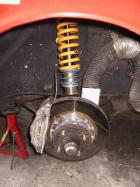This article will focus on even better brake choices, after you've got the Z or ZX struts. See 280ZX Strut Swap for details.
Contents |
Overview
Z means 240Z, 260Z or 280Z (Nissan chassis code S30). ZX means 280ZX (S130) which came 1979-1982.
Rotor Comparo
- 240/260/280Z: 272 mm (10.7") non-ventilated
- 280ZX rotors: 254 mm (10.0") ventilated, 18 mm thick, fit Z-car struts
- 280ZX rotors: 258 mm (10.15") lightweight non-ventilated, fit 1200 disc struts
- 300ZX rotors: 274 mm (10.8") ventilated, 22 mm thick, don't fit 280ZX struts
All the Z and 280ZX struts will allow interchange of any rotor onto any hub as far as being able to be physically bolted together. In other words, any Z or ZX 4-bolt hub will accept any other Z or ZX brake rotor. However the rotor thickness and offset are more important. Also any Z or ZX 4 bolt hub will also fit onto the Z spindle too, with the only difference being a very slight displacement of inside seal (the wheel bearings are the same).
Note that the Z has more positive camber than the ZX struts, so the ZX is superior for swapping.
300ZX calipers are wider, heavier, and had a different bolt spacing than did the 280ZX or Z calipers, even though the piston and pad area on these calipers was no bigger than the piston and pad area on the 280ZX caliper.
Apparently the stock non-ventilated rotor is close to overheating on a 2800 pound Z-car, but is fine on a lightweight 1200 for street driving.
It seems the 280ZX strut lets you use a 1" smaller diameter wheel than Z struts. 280ZX allows 13" alloys. And they are ventilated, so a double-win for ZX brakes over Z brakes.
Adventurous swapsters: notice that 1981 Toyota Cressida caliper bolts to the Z-car strut and has slightly smaller piston and pads. What size rotor does the Cressida have?
Ventilated 300ZX Rotor on Z Strut
If you want the large 300ZX rotor, use them with a 280ZX caliper, as 300ZX calipers don't bolt on, having the bolt spacing farther apart.
- The caliper has the bolt threads. So drill out the Z-car strut to fit them and put bolts through the strut holes into the caliper
- Use a spacer on the caliper bolts to center the caliper over the rotor. Use early 240Z hubs. A thick .160" washer, is placed between the caliper and the strut. If using newer hubs, which are thicker, it won't be a bolt on, but probably you'd have to machine the hub.
- Machine the larger 300ZX rotor down to reduce diamter by about 1/4 inch (it should just come past the brake pads)
reference: Z Home
Wilwood Dynalite Calipers on 280ZX Struts
Perhaps the most effective braking system you can get on a 1200/120Y/B210 etc... ( at least as good as the FIA brakes at a much lower cost. ) It's an upgrade that will last the life of the vehicle.
This upgrade requires all the work done to swap in the 280zx struts in addition to a custom caliper adapter.
Some people have mentioned that some Wilwood calipers do not have dust seals and as such may not be road worthy in some places (Australia for one!) I've been looking for an answer to that question. Dynalite calipers don't have dust seals and allegedly don't need them, Dynapro calipers MAY have dust seals, but I can't verify that.
Benefits
1. Significantly lighter than 280zx calipers. ( any unsprung weight savings are good on those heavy strut assemblies )
2. 4 pistons
3. Wide range of pads from street to severe duty race pads without spending any more than regular pads.
4. Many people consider the Wilwood caliper to be more reliable than the OEM calipers, not needing rebuilds for years.
5. No machining of brake disks to fit them. Once you have them installed all service parts are regular off the shelve parts.
Disadvantages
1. Lack of dust seals may be a problem if you need to get upgrades engineered. At least some engineers will OK them.
2. If used on a track car, you'll be put in a class with much more powerful cars.
3. 14" or larger wheels needed. Some wheels may require spacers, 14" 280zx and 280zx Turbo wheels have a different offset, so non-turbo wheels may not need spacers. 280zx Turbo wheels may also need a little bit of grinding to clear the caliper, and even then the space between the caliper and wheel spokes may be extremely small, also the nut that holds the caliper to the adapter will have a very small amount of clearance to the brake disk.
4. Installation will require removing splash guards from disks, which may cause problems if the upgrade needs to be engineered.
Installation Notes
Installation of these calipers is fairly easy. You need to source an adapter to attach the brakes to 280zx struts, look around on 280ZX sites or check ebay. If you're going to this length, you'll want to get some stainless steel flex brake lines, and the proper adapters for them. Also make sure to retain or replace the flex hose support on the strut or you could have engineering issues. The adapter I used in my install required some very thin profile special nuts to attach the caliper to the adapter plate, so keeping a set of spares on hand would be a very good idea.
- Service kits are available for a very reasonable price ( about $10 USD )
- Adapter plates should run about $100 - 200 USD
- Wilwood calipers aren't that expensive... About $130 - 150 USD per caliper vs. $50 USD for an average 280zx caliper. vs $300 USD! for the Nismo MK63 Sumitomo 4 pot caliper.

![[Datsun 1200 encyclopedia]](/wiki/upload/wiki.png)
